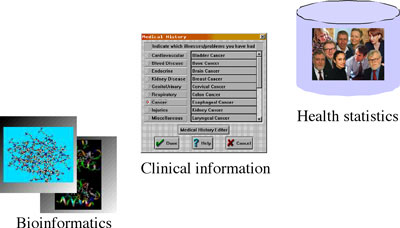SemanticMining - A Network of Excellence in the Field of Biomedical Informatics
by Hans Åhlfeldt
The objective of the Network of Excellence entitled Semantic Interoperability and Data Mining in Biomedicine [SemanticMning] funded by the European Sixth Framework Programme, is to establish Europe as the international scientific leader in medical and biomedical informatics.
The long-term goal of the network will be the development of generic methods and tools supporting the critical tasks of the field; data mining, knowledge discovery, knowledge representation, abstraction and indexing of information, semantic-based information retrieval in a complex and high-dimensional information space, and knowledge-based adaptive systems for provision of decision support for dissemination of evidence based medicine.
The general objective of a Network of Excellence (NoE) is to bridge gaps in the European research infrastructure and to facilitate cross-fertilisation between scientific disciplines. Traditionally academic departments in the domain have their roots either in computer science, system engineering (including a variety of engineering disciplines) or in a medical or clinical context. The proposed network is composed of partners from these scientific areas, all bringing their experience and in-depths knowledge together into a common framework. An important aspect of this is the merging of medical or clinical informatics and bioinformatics including the new fields of genomics and proteomics.
Another bridging activity addressed by this NoE is knowledge transfer and co-operation between academia and organisations and SMEs in the health and welfare sector, including standardisation bodies and the different public and private institutions involved in health care delivery and management. The national institutes and organisations responsible for policy making and quality management with a regulatory and normative function will have an important role to play in the network. We believe that co-operation between these organisations and those involved in research departments needs to be strengthen, both in the early phase of research programme identification and in the later phases of implementation and large-scale evaluation of results and impact. The bridging activities between different levels of the health care system are exemplified in the figure.
|
The research activities in Semantic Mining is focused around seven areas:
- principles in ontology engineering
- evaluation of SNOMED CT
- impact of ontologies on health statistics
- concept systems in laboratory medicine
- the construction of a multi-lingual medical dictionary
- text mining and information retrieval in bioinformatics
- the concept-based electronic health record.
Researchers in the network play an influential role in the process of harmonisation and further development of terminology systems. Examples of areas of interaction are the Gene Ontology, the Foundational Model of Anatomy, and SNOMED CT. Part of the network objectives is also an active interaction with standardisation bodies such as CEN TC251, IMIA and W3C. The research carried out under the auspices of this NoE will also address the need for approaches in Europe which will bridge language barriers and facilitate access for non-English native persons to the large scientific corpus of texts written in English.
SemanticMining is based on the partnership of 25 partners from 11 European countries with approximately 100 identified researchers (25 female) and 35 associated PhD students (10 female).
Link:
http://www.semanticmining.org
Please contact:
Hans Åhlfeldt, Coordinator,
Linköping University, Sweden
Tel: +46 13 227574
E-mail: hans.ahlfeldt![]() imt.liu.se
imt.liu.se

 This issue in
This issue in 
